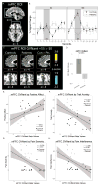Altered prefrontal correlates of monetary anticipation and outcome in chronic pain
- PMID: 29790868
- PMCID: PMC6053327
- DOI: 10.1097/j.pain.0000000000001232
Altered prefrontal correlates of monetary anticipation and outcome in chronic pain
Abstract
Chronic pain may alter both affect- and value-related behaviors, which represents a potentially treatable aspect of chronic pain experience. Current understanding of how chronic pain influences the function of brain reward systems, however, is limited. Using a monetary incentive delay task and functional magnetic resonance imaging (fMRI), we measured neural correlates of reward anticipation and outcomes in female participants with the chronic pain condition of fibromyalgia (N = 17) and age-matched, pain-free, female controls (N = 15). We hypothesized that patients would demonstrate lower positive arousal, as well as altered reward anticipation and outcome activity within corticostriatal circuits implicated in reward processing. Patients demonstrated lower arousal ratings as compared with controls, but no group differences were observed for valence, positive arousal, or negative arousal ratings. Group fMRI analyses were conducted to determine predetermined region of interest, nucleus accumbens (NAcc) and medial prefrontal cortex (mPFC), responses to potential gains, potential losses, reward outcomes, and punishment outcomes. Compared with controls, patients demonstrated similar, although slightly reduced, NAcc activity during gain anticipation. Conversely, patients demonstrated dramatically reduced mPFC activity during gain anticipation-possibly related to lower estimated reward probabilities. Further, patients demonstrated normal mPFC activity to reward outcomes, but dramatically heightened mPFC activity to no-loss (nonpunishment) outcomes. In parallel to NAcc and mPFC responses, patients demonstrated slightly reduced activity during reward anticipation in other brain regions, which included the ventral tegmental area, anterior cingulate cortex, and anterior insular cortex. Together, these results implicate altered corticostriatal processing of monetary rewards in chronic pain.
Conflict of interest statement
Conflict of Interest Statement:
Other than the cited funding sources, the authors have no financial interests to disclose.
Figures






Similar articles
-
Affective traits link to reliable neural markers of incentive anticipation.Neuroimage. 2014 Jan 1;84:279-89. doi: 10.1016/j.neuroimage.2013.08.055. Epub 2013 Aug 31. Neuroimage. 2014. PMID: 24001457 Free PMC article. Clinical Trial.
-
Striatal and septo-hypothalamic responses to anticipation and outcome of affiliative rewards.Neuroimage. 2021 Nov;243:118474. doi: 10.1016/j.neuroimage.2021.118474. Epub 2021 Aug 15. Neuroimage. 2021. PMID: 34407439
-
Altered resting-state functional connectivity within corticostriatal and subcortical-striatal circuits in chronic pain.Sci Rep. 2022 Jul 25;12(1):12683. doi: 10.1038/s41598-022-16835-7. Sci Rep. 2022. PMID: 35879602 Free PMC article.
-
Neural substrates of reward anticipation and outcome in schizophrenia: a meta-analysis of fMRI findings in the monetary incentive delay task.Transl Psychiatry. 2022 Oct 16;12(1):448. doi: 10.1038/s41398-022-02201-8. Transl Psychiatry. 2022. PMID: 36244990 Free PMC article.
-
The Neural Substrate of Reward Anticipation in Health: A Meta-Analysis of fMRI Findings in the Monetary Incentive Delay Task.Neuropsychol Rev. 2018 Dec;28(4):496-506. doi: 10.1007/s11065-018-9385-5. Epub 2018 Sep 25. Neuropsychol Rev. 2018. PMID: 30255220 Free PMC article.
Cited by
-
Reward Responsiveness in Patients with Opioid Use Disorder on Opioid Agonist Treatment: Role of Comorbid Chronic Pain.Pain Med. 2021 Sep 8;22(9):2019-2027. doi: 10.1093/pm/pnab031. Pain Med. 2021. PMID: 33624802 Free PMC article.
-
Increased behavioural inhibition and decreased behavioural activation in whiplash-associated disorders: Associations with health outcomes.Eur J Pain. 2025 Feb;29(2):e4721. doi: 10.1002/ejp.4721. Epub 2024 Sep 22. Eur J Pain. 2025. PMID: 39308011 Free PMC article.
-
Enhanced motor network engagement during reward gain anticipation in fibromyalgia.Cortex. 2024 Apr;173:161-174. doi: 10.1016/j.cortex.2023.12.017. Epub 2024 Feb 7. Cortex. 2024. PMID: 38417389 Free PMC article.
-
Evaluation by Survival Analysis of Cold Pain Tolerance in Patients with Fibromyalgia and Opioid Use.J Pain Res. 2022 Sep 9;15:2783-2799. doi: 10.2147/JPR.S368805. eCollection 2022. J Pain Res. 2022. PMID: 36111289 Free PMC article.
-
Reward Processing and Circuit Dysregulation in Posttraumatic Stress Disorder.Front Psychiatry. 2021 May 28;12:559401. doi: 10.3389/fpsyt.2021.559401. eCollection 2021. Front Psychiatry. 2021. PMID: 34122157 Free PMC article.
References
-
- Apkarian AV, Sosa Y, Krauss BR, Thomas PS, Fredrickson BE, Levy RE, Harden RN, Chialvo DR. Chronic pain patients are impaired on an emotional decision-making task. Pain. 2004;108:129–136. - PubMed
MeSH terms
Grants and funding
LinkOut - more resources
Full Text Sources
Other Literature Sources
Medical

